This small Arabian peninsula wants to showcase its culture to the world through ‘Qatar Vision 2030’, a project that began in 2008 for the sustainable growth and development of the country with the aim of transforming Qatar into an advanced society while maintaining its origins and traditions.
The growth of this country is unstoppable, through its museums, galleries, universities, libraries and gastronomy, Qatar wants to pay homage to its culture in many ways, proof of this are the buildings that reflect the traditions of Doha, the local and international artists whoinvade the streets with urban art through murals or by creating sculptures with symbols of their country, inviting reflection.

From left to right iconic representation of Qatar’s culture with five bronze horses created by Wolfgang and Heron, ‘Force of Nature II’ a sculpture of a woman holding the planet with a canvas by artist Lorenzo Quin and the giant whale ‘Dugong’ by Jeff Koons.
The architecture in Qatar is characterised by cultural, modern and futuristic elements. The result of the economic development of the last few decades is its spectacular skyline made possible by the collaboration of some of the world’s best architects.

From left to right: National Museum designed by the French architect Jean Nouvel, Rafles Doha Building and the Fairmont are two hotels designed by the American studio HOK, The Palm Towers recreating the trunk of a palm tree is created by the UK-based studio RMJM, The Doha Torch or ‘Aspire Tower’ was designed by the architect Simaan Hadi.
There are many cultural symbols in its buildings such as the Mondrian Hotel in Lusail (15 km. The NMoQNational Museum, designed by architect Jean Nouvel, the Katara Towers emulating the crossed scimitar swords emblem of the country, or The Torch Doha representing an antorch and created for the 2006 Asian Games. It is the tallest building in Qatar at 300 metres.
If you have along weekend, we suggest a three-day route so that you can discover the must-see sights of the capital Doha and the surrounding area.
Day 1:a tour of museums and the souk
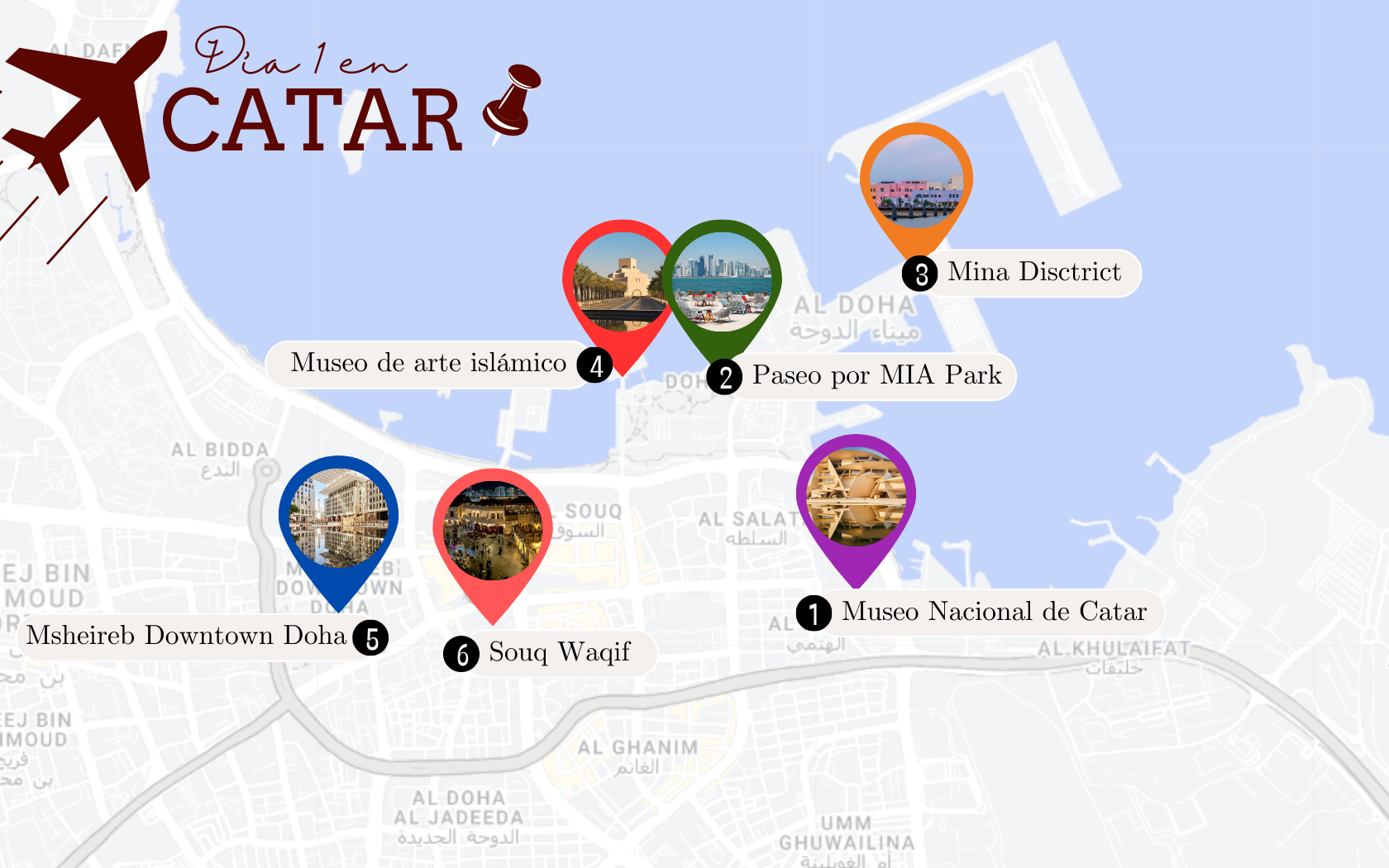
Day 1 tour in Qatar
- NMoQ_National Museum of Qatar.
We began our tour by delving into thehistory and culture of the Qatari people by visiting the NMoQ (National Museum of Qatar), which impresses with its architectural form of 539 interlocking white discs that recreate the rosy desert, designed by the famous French architect Jean Nouvel. Incidentally, the floor is uneven, imitating the desert dunes.

There are eleven galleries where the past, present and future are explored through a multi-sensory experience: from prehistoric times, fauna, flora, the life of the fishermen on the coast and the Bedouins in the desert, the discovery of oil and gas to the present day.
- Walk through the MIA Park and MINA District
Leaving the NMoQ, after just 1.7 km you’ll come to MIA Park, a promenade with beautiful views of Doha’s skyline. Continuing to the end of the promenade, in Doha’s old port, you’ll come across MINA district, a group of pastel-painted buildings inspired by the architecture of the houses called Roshas on the coast of Qatar.

The Mina District Corniche and MIA Park promenade
Mina District is home to restaurants, cafes, shops, hotels and also a fish market where you can buy fish and seafood. We took the opportunity to have lunch and sit on one of the terraces to watch the ships coming and going from the port where the cruise terminal is now located.
- MIA Museum of Islamic Art
A short distance from the MINA District (1.5 km) is the Museum of Islamic Art, built on an artificial island 60 metres off the coast so that no building could encroach on it in the future. The Sheikh Hamad Bin Khalifa Al Thani, father of the current emir, wanted to build this museum to turn Qatar into the cultural capital of the Gulf. Designed by the Sino-American architect Ieoh Ming Pei who was inspired by the Ibn Tulun Mosque in Cairo, Egypt, for the simplicity of its lines.

Museum with views of the city skyline and the Arabian Sea.
It consists of 4 floors of temporary and permanent exhibitions where it houses the largest collection of Islamic art from the 3 continents, with unique objects from all over the world. On the fifth floor is IDAM, the restaurant of the renowned chef Alain Ducasse.
- Msheireb Downtown Doha: considered the most sustainable smart city in the world.
Msheireb is now what was once Doha’s first commercial district, where the first schools, pharmacies and, in the 1950s, electricity was installed for the first time.
The government wanted to renovate this district and built this energy regeneration project, with clean transport, automatic waste collection, a system of underground tunnels to eliminate commercial vehicle traffic. All buildings are constructed with sustainable materials.
It is the first pedestrianised district. Due to the sun and high temperatures, the streets are designed to distribute the cold and increase its cooling, take advantage of solar energy and improve the intensity of light by means of retractable roofs. The streets are designed to distribute the cold and increase its cooling, take advantage of solar energy and improve the intensity of light by means of retractable roofs.
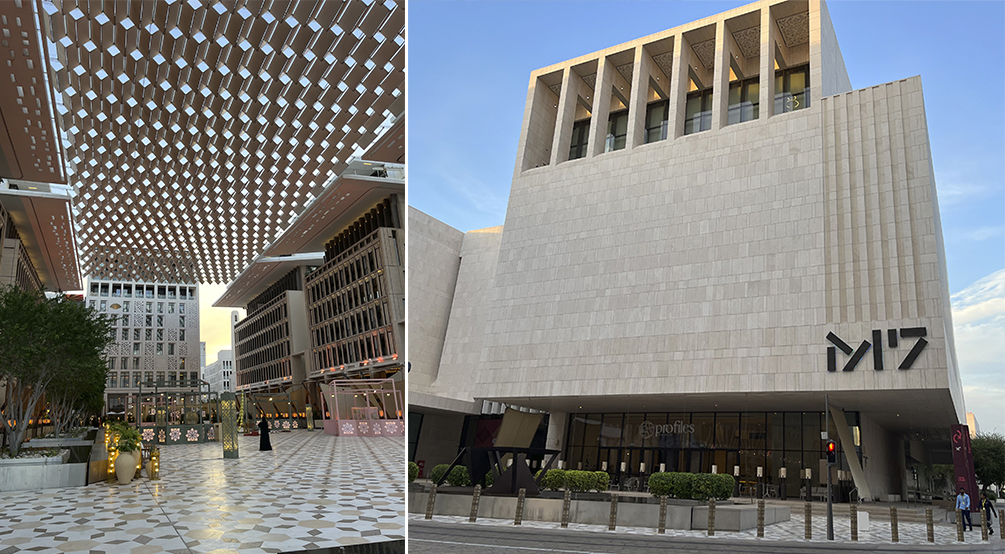
Left Msheireb Downtown main square in the heart of Doha. Right the M7 Museum is the epicentre of design, fashion and technology.
This area also has four houses adapted as museums: the Al-Eid mosque, the Msheireb museums to showcase the country’s history and the M7 building, Doha’s new cultural hub, created by Sheikha Al-Mayassa, sister of the current sheikh of Qatar and considered the most powerful woman in the world of art. At M7 she gives all artists and designers the opportunity to exhibit. It is the epicentre for design, innovation and entrepreneurship.
- Souq Souq Waqif (the oldest part)
In the evening we head to the bustling Souq Waqif (Souq = market and Waqif = passing through) a market in the heart of Doha that unites tradition with products from all over the regionfrom antiques, fabrics, carpets, glass and ceramic handicrafts, perfumes, gold jewellery, natural and cultured pearls. As a souvenir you can take home a temporary fresh henna tattoo created by an artist.
 Among its labyrinthine alleyways of traditional mud-smeared houses, you’ll find the Hawk Souk where you can buy all kinds of accessories and where they also have a hospital dedicated to the treatment and care of their national bird (anecdotally, the falcon is the only animal that is allowed to carry a maximum of 7 per flight on Qatar Airways economy airlines). Nearby are the stables with purebred Arabian horses and the camels that come out in the mornings and afternoons for a stroll around the Amiri Diwan (parliament).
Among its labyrinthine alleyways of traditional mud-smeared houses, you’ll find the Hawk Souk where you can buy all kinds of accessories and where they also have a hospital dedicated to the treatment and care of their national bird (anecdotally, the falcon is the only animal that is allowed to carry a maximum of 7 per flight on Qatar Airways economy airlines). Nearby are the stables with purebred Arabian horses and the camels that come out in the mornings and afternoons for a stroll around the Amiri Diwan (parliament).
Another must are the spices that flavour the streets, from saffron, dried flowers, black lemons, dates or coffee beans and the typical products of their region.
In the souk you can taste the most typical Arab cuisine in the country, from Machboos, Kebabs, hummus, falafel, shawarma or luqaimat to a wide variety of international restaurants with Asian, Argentinian, Turkish or Russian cuisine.
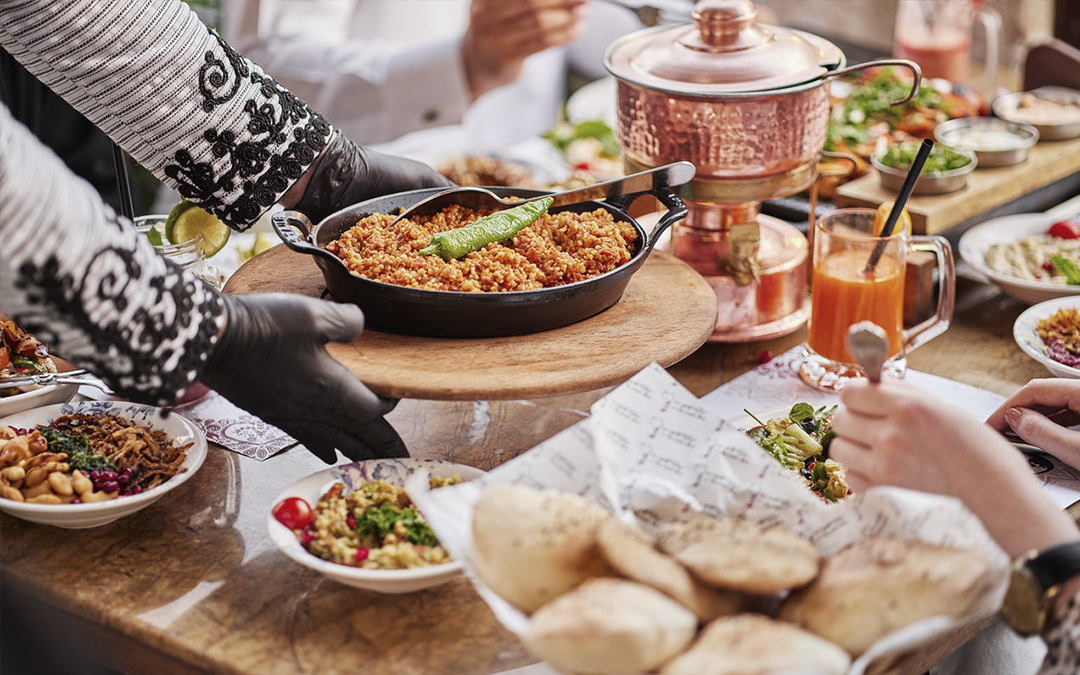
In 2003 it suffered a fire which damaged part of its infrastructure and in 2006 the government carried out a restoration and renovation project in which they wanted to maintain the original architecture.
Day 2: Cultural city, visit the Blue Mosque, lunch at the Pearl Island, afternoon desert safari and sunset at a resort.

Tour day 2 Qatar
- Katara Cultural Village north of the capital of Doha, opened in 2010.
Because of the importance of promoting culture and art, Khalifa bin Hamad Al Thani (father of the current emir), created Katara Village, a small village with museums, art galleries, cinemas, restaurants and even an amphitheatre overlooking the sea for open-air performances and cultural events.

The Katara amphitheatre was recreated from classical Greek-Roman theatre with traditional Islamic features.
The Blue Mosque of Katara, designed by Turkish architect Zeynep Fadilloglu, is notable for its impressive hand-painted tile mosaic art featuring scriptural verses or traditional vegetal motifs. Normally the minaret (tower) is integrated with the mosque, but here they were separated into two buildings.

the traditional Doha Dovecotes and right, the Blue Mosque of Katara.
To the left of the mosque are thePigeon Towers where pigeons were once kept and their waste used as fertiliser. This is another traditional Qatari symbol that they wanted to replicate because it is part of their culture.
The second mosque in Katara is the Golden Mosque, which is covered with gold leaf mosaic tiles.
The artificial island of The Pearl Qatar (13 kms. from Doha)
It has a residential area with offices, hotels, restaurants and cafés, where you can stroll and shop. The marina is a favourite place to have a drink overlooking the yachts.
- Qanat Quartier
It’s the neighbourhood inside La Perla that recreates a Mediterranean atmosphere with colourful houses and sloping tiled roofs. In addition to restaurants and shops, there is a man-made Grand Canal which is inspired by the Grand Canal of Venice where you can also take the boat-taxi for transfers.

- St Regis Marsa Arabia Island
It’s another of La Perla’s most exclusive locations. The St. Regis Marsa Arabia Hotel is located on a private island in the heart of the luxury Porto Arabia resort, a collection of 31 Mediterranean-style residential towers with a marina, local and international restaurants and luxury shops. From a bird’s eye view, we see the shell shape with a pearl in the centre that is this island.
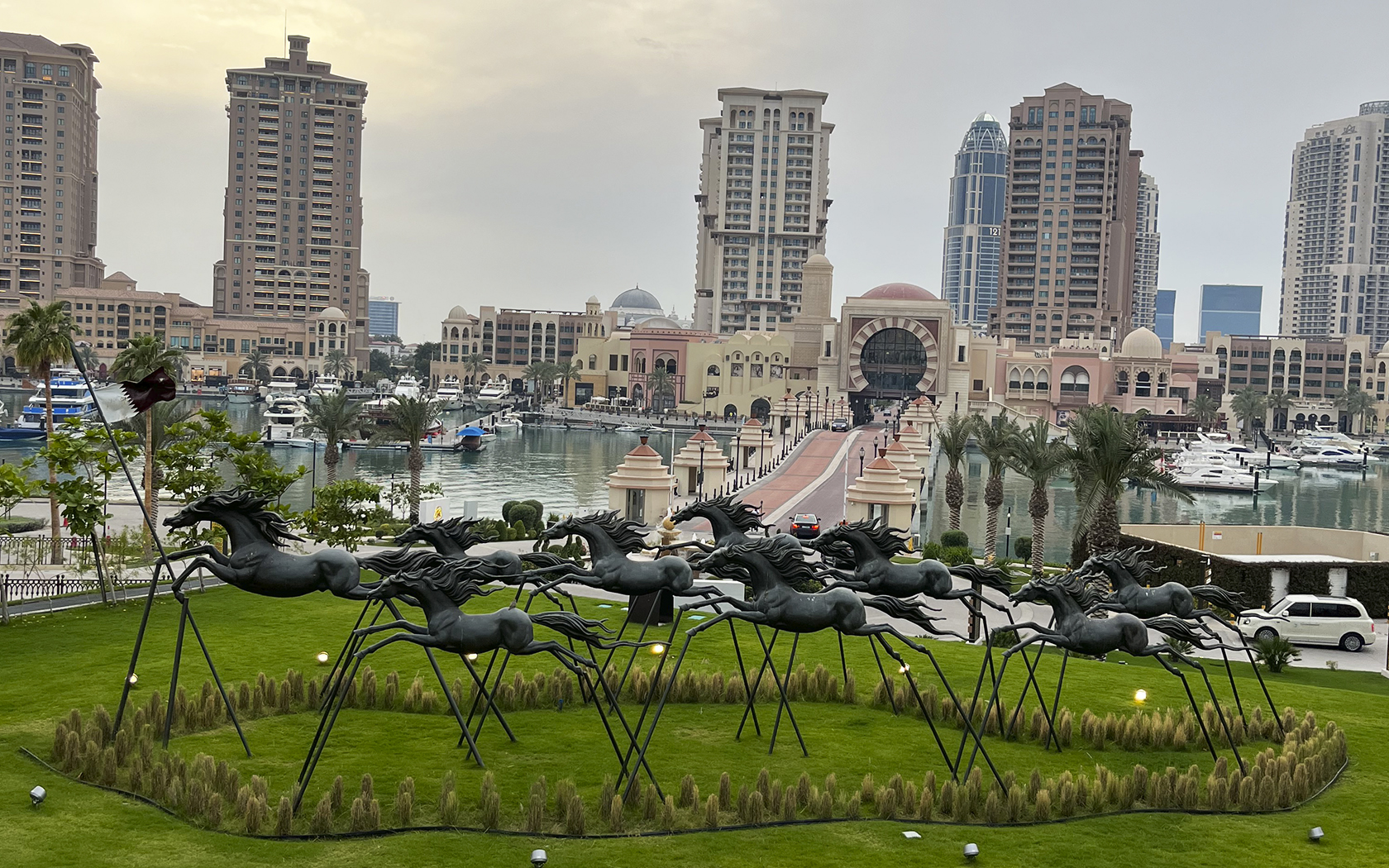
The marina of Porto Arabia is one of the main hubs of La Perla.
The St. Regis Marsa Arabia Hotel features a huge Clinique La Prairie signature spa, local and international restaurants and experiences.
- Safari to Inland Sea Beach
In the afternoon, we head towards the inland sea of Khor Al Adaid (60 km from Doha), where you can hire a private tour and decide whether to go by 4X4, boogie, quad or dromedary to feel the sound of the desert dunes until we reach the border with Saudi Arabia, one of the most impressive places in Qatar where the sea enters the desert.

Once there, it’s all about contemplating the horizon, the sea and the silence of the dunes.
- Sunset and accommodation at The Outpost al Barari
In Mesaieed, 24 minutes from the inland sea, we headed to The Outpost Al Barari, a resort to relax and enjoy the gastronomic experiences and activities on offer: such as a guided walk to do a walking dive in the desert, a 50m balloon ride, open-air cinema, massages or a romantic dinner.
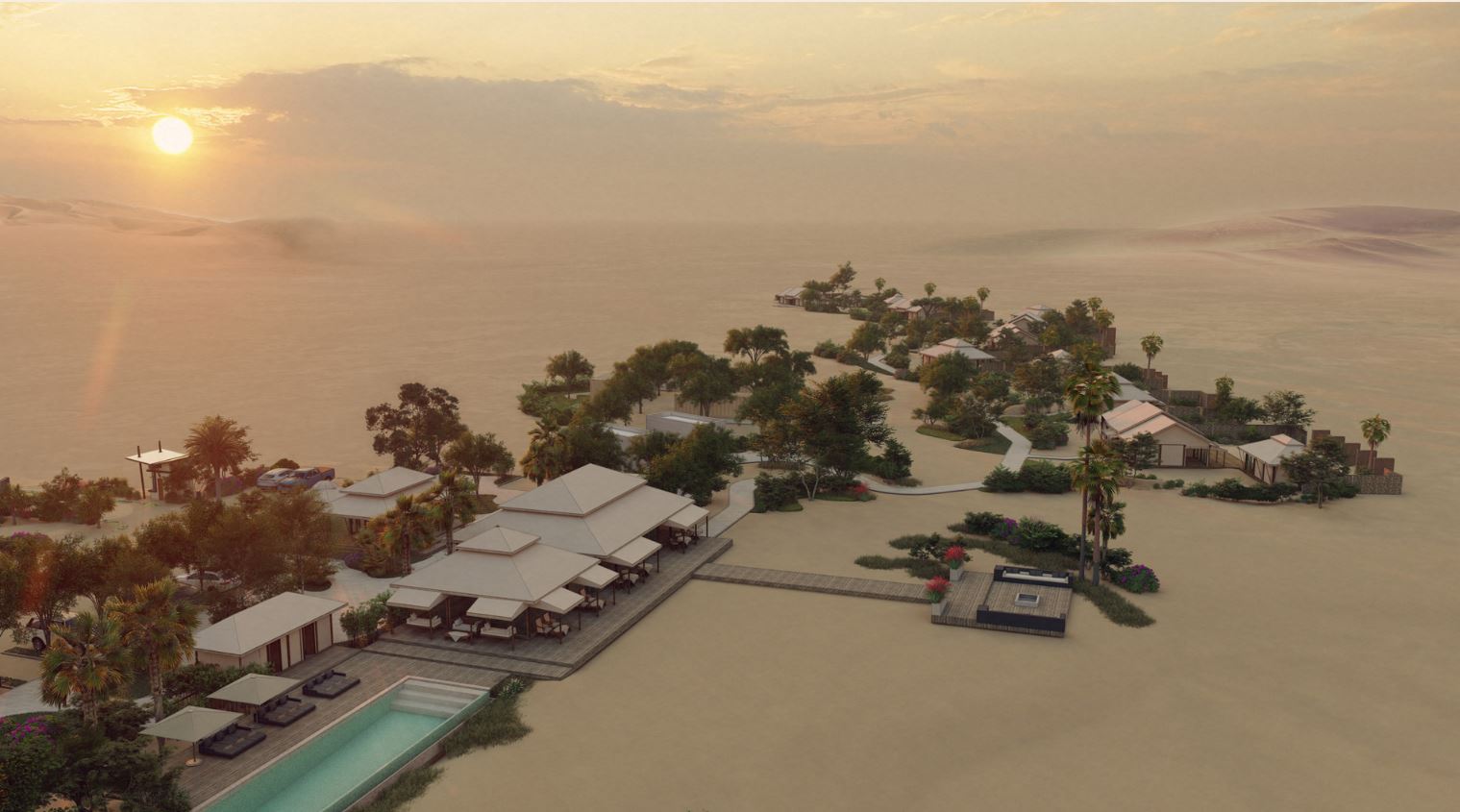
Sunset in Outpost al Barari
The resort has 21 luxury accommodations with private pools located in the nature reserve of the Inland Sea surrounded by dunes, an ideal place to lose yourself and relax.
DAY 3 Education City and Hennat Salma Farm

Infographic tour day 3 Qatar
- Education City
Sheikh Hamad bin Khalifa Al Thani, father of the current emir, took power in 1995 and in 1996 they made their first exports of liquefied gas.
With the country’s abundant economic inflows, the emir wanted to give his people better education and health. This year he and his second wife Sheika Mozah set up the non-profit Cathar Foundation for Education, Science and Community Development, which houses 14kms of 8 international universities for students from Qatar and around the world, research institutes and a conference centre.

Education City is home to branches of the world’s most prestigious universities, such as Weill Cornell Medical College, Texas A&M, Georgetown School and Carnegie Mellon University.
There is also a mosque which is part of the Faculty of Islamic Studies (CEI) at Hamad Bin Khalifa University. It is supported by 5 pillars which are the 5 pillars of Islam: prayer, faith, fasting, charity and pilgrimage to Mecca. There are two towers that are pointing to Mecca.
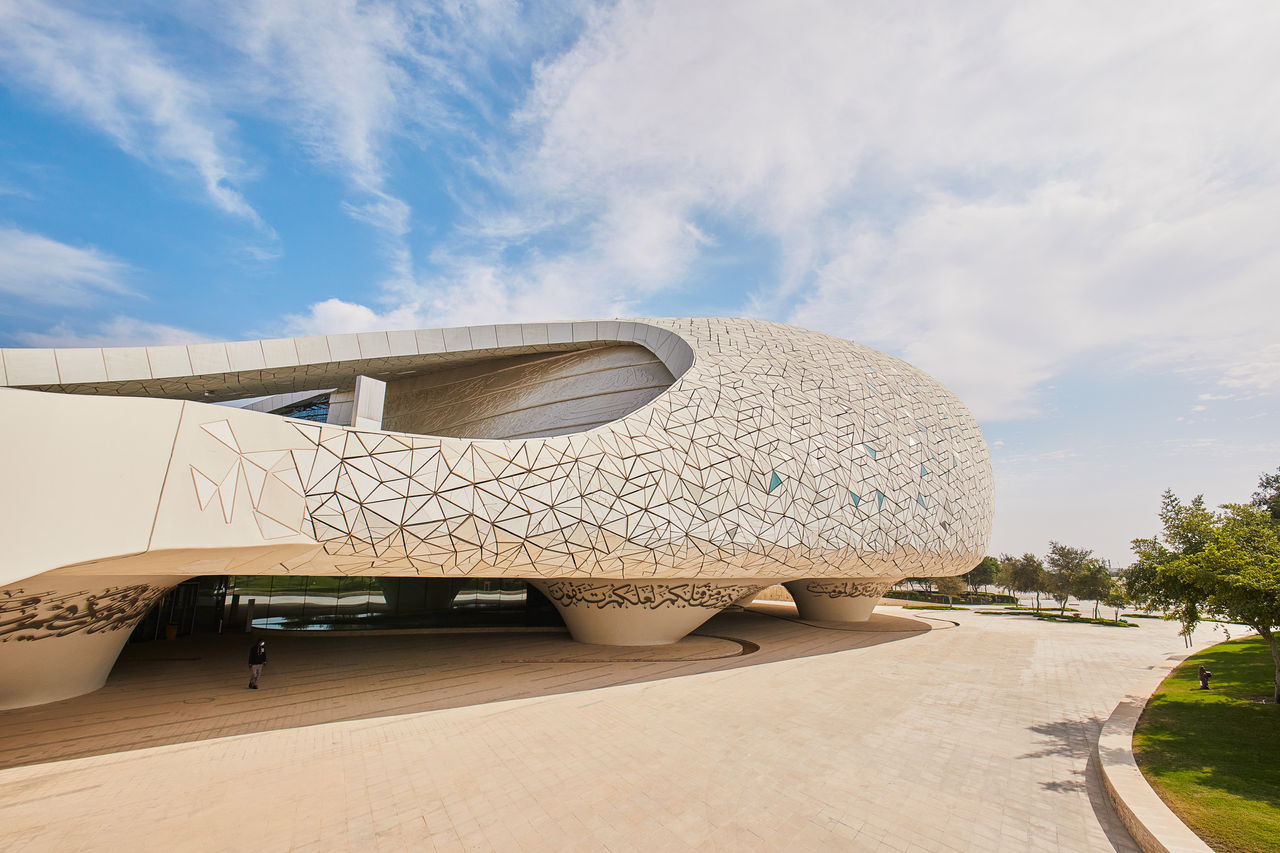
The mosque has a completely different design from traditional mosques.
- Qatar National Library, is the national library of Qatar, which opened on 7 November 2017.
It has 1 million books in 22 different languages and 500,000 e-books and functions as a national library, central public library and university research library.
Designed by Dutch architect Rem Koolhaas, it is a building with many symbolisms, the façade is shaped like folded paper. It operates under the umbrella of the Qatar Foundation with the aim of social progress in the country, and is one of the world’s leading research centres.

National Library
There is an excavation where you can find many Arabic books and objects of the heritage of Qatar and the region, also an auditorium for different events, for example the philharmonic orchestra performs every month. It is an inclusive library.
- Heenat Salma Farm
Our next destination is 22 minutes away from Education City, an ecological farm that will not leave you indifferent. A project dedicated to holistic methods in agriculture, architecture and community development.

Heenat Salma Farm
It diversifies local food production and contributes to a supply of renewable home-grown food in Qatar. They run craft workshops and have a spa where wellness comes first.
Is there a better way to end a journey?
12 Highlights from Qatar
- Qatar was originally a pearl fishing and pearling country..
- It is one of the cleanest countries in the world.
- The two animals representing Qatar are the Orix (antelope) and the Hawk (bird).
- It is the third country with the largest natural gas reserves, followed by Russia and Iran.
- It is a tax-free country.
- It is one of the safest cities in the world. There are cameras in the streets and public places.
- The cruise season is from November to April.
- In June, July and August there is a whale shark tour.
- They have the most modern metro in the world with business and tourist categories.
- 61% of the water comes from a water desalination system from the sea.
- Sheika Al Mayassa Bin Hamad Bin Khalifa Al Thani, Al Thabi’s sister, has the largest art collection in the world.
- The stadium 974 is so called because that is the number of containers it is built in and because 974 is the international call number.
Qatar Airways is the national airline of the State of Qatar. It currently operates a global network of more than 160 destinations worldwide, connected through its hub, Hamad International Airport (HIA) in Doha (named Best Airport in the World).
In 2022, to coincide with the airline’s 25th anniversary, Qatar Airways was awarded ‘Airline of the Year’ (for an unprecedented seventh time) by the international air transport ratings organisation Skytrax, as well as winning further awards for ‘World’s Best Business Class’, ‘World’s Best Business Lounge Catering’ and ‘Best Airline in the Middle East’.
Flight frequencies from Spain:
MADRID (18 weekly flights) every day.
BARCELONA (14 weekly flights)every day.
MÁLAGA* (3 weekly flights) Mondays, Fridays and Sundays..
Before visiting Qatar for the first time, we suggest hiring a guide and recommend Marisol @mashistar74 who speaks English and Spanish and has been living in Qatar for more than a decade and has a great knowledge of its culture and customs.
Images by Horse and Qatar Tourism




